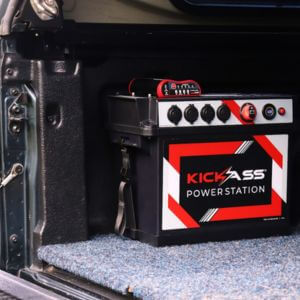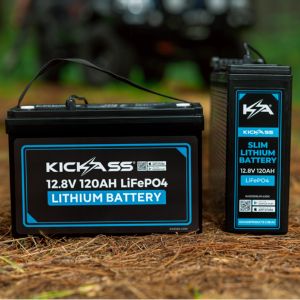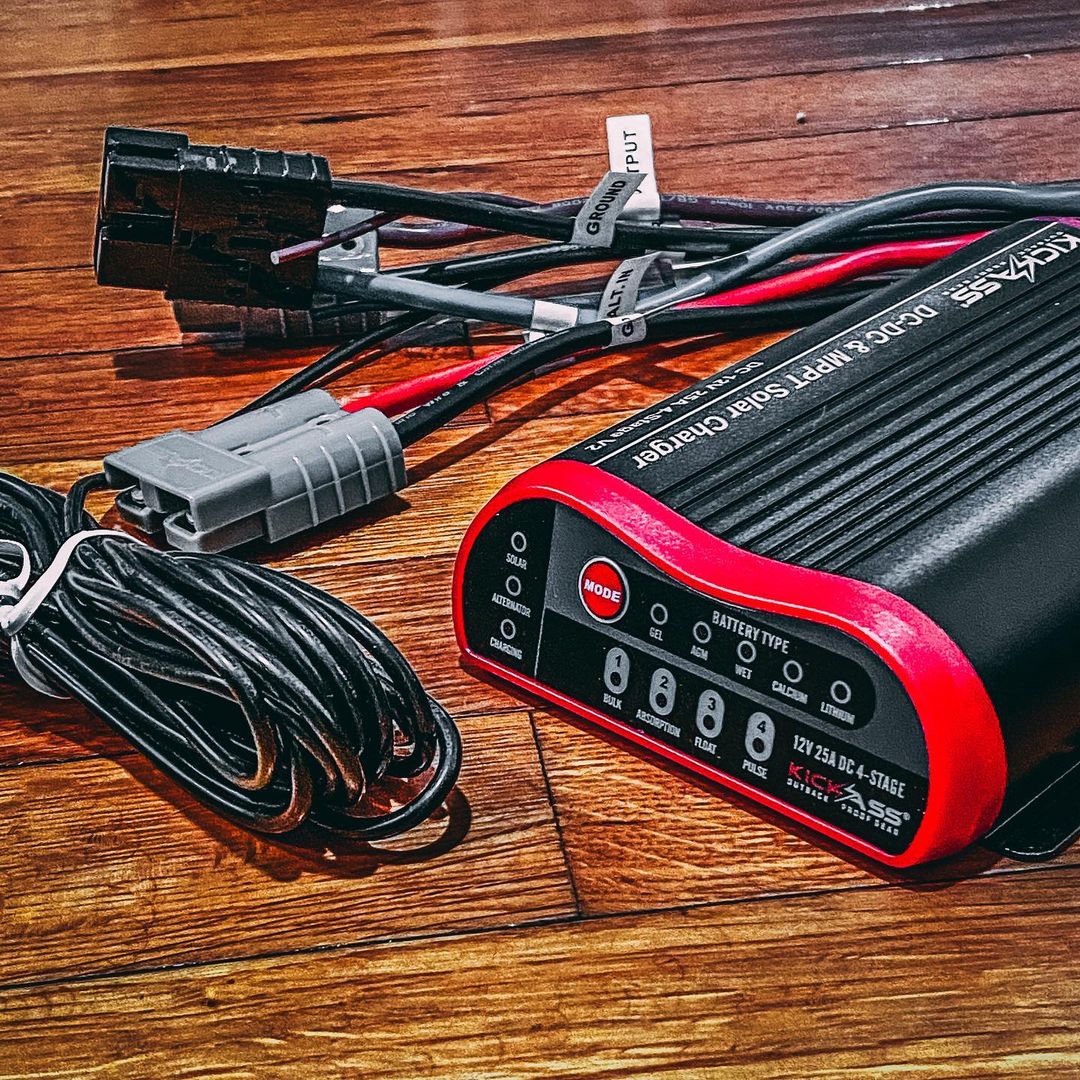The KickAss Offerings
KickAss Products recently started importing their batteries, chargers, and accessory components into the USA, so I decided to build my overland auxiliary power system around two of their most popular offerings — the slim 170ah AGM battery and their DCDC controller. Since they are newer to the US market, I’m excited to review them and share my thoughts on how these products might work in your rig.
KickAss 170ah Slim AGM Battery
The KickAss 170ah slim AGM battery is a beast and the unique form factor and budget-friendly price point make it a serious contender for anyone looking to power their adventures further. The battery measures 21.75” long, 11.5” tall, and 4.5” wide and tips the scales at 100 lbs. It includes a pair of removable rope carry handles, M8 terminals, and a removable plastic cover to protect the terminals. The battery is fully sealed in an ABS plastic casing, making it strong and resistant to chemical erosion, impact, or (important for overlanders) high vibration environments.
The UPS man probably wasn’t super happy to bring this box to my door given the weight, but the rope carry handles actually make it pretty manageable to move around once unboxed. In Australia, KickAss also offers this slim battery in a 120ah size, and I’m hoping they will bring that and their line of battery trays to mount these beasts to the US market soon.
Based on my calculations, the 170ah battery should last at least three full days powering our Dometic CFX-35 fridge in normal operating environments. By this, I mean using the fridge in warm or hot ambient temperatures with regular opening and closing of the fridge door. You know, like how you actually use a fridge. Of course, that assumes no charge going into the battery at all, and since our Jeep is also a daily driver, the normal day-to-day commute and exposure to sunlight when parked outside should keep the battery in tip-top shape for adventures. Of course, we will report back with actual usage data once we have a few more miles under the battery.
KickAss 25A DCDC Charger with MPPT Controller
There are a few companies marketing DCDC chargers with MPPT controllers to the overland community in the United States, and they all essentially do the same thing — put the juice back into the battery either via the car’s alternator or a solar panel. In the end, choosing which model to go with depends on your personal preference for a few key features. For instance, the KickAss 25A DCDC with MMPT charger is the only one on the market that comes pre-wired with Anderson-type connectors, making it literally a plug-and-play installation. If you have little-to-no wiring expertise, this really sets the KickAss product apart; they have taken the labor of safely wiring these components out and made this as easy as possible.
I would describe my own comfort with automotive wiring systems as moderate. In other words, good enough that I’m comfortable crimping a few wires, adding some heat shrink, etc. You’re not going to see me whipping out a soldering iron or reading some fancy wiring diagram. So the KickAss kit fits right in my sweet spot. They’ve taken enough guesswork out that I can install this myself (and walk you through the install), but not pushed me out of my comfort zone. This is great — I’m always happy to install projects I feel are within my own scope of capabilities.
The controller itself comes in a metal housing measuring 6.5” long, 4.75” wide, and less than 2” tall. It has IP67 dust and waterproof rating, meaning it can be submerged in 3ft of water for 30 minutes — not that I’d recommend testing that out. But it proves that this is a solidly built product that won’t be phased by a little mud and grime that it could be exposed to in the course of an adventure.
Included with the charger is everything you need to wire it up, including some spare wire crimps and a heat shrink tube. If you get the additional wiring kit, you literally have everything needed for the basic installation.
KickAss really nailed it by adding a few additional optional features for the system. One optional feature, that I would highly recommend utilizing, is the ignition cut-in wire. This blue wire can be extended and routed up to the fuse box of the vehicle, where you can then tap into an ignition-powered fuse. This tells the charger when the car is running, allowing it to smart charge from the alternator. KickAss designed this to also have a time delay so that the starter battery can re-charge for a few seconds before the auxiliary battery starts to draw from it. Smart!
The other fun option is a brown wire for an external LED. This can be wired to an aftermarket LED light that indicates when the charger is on. It doesn’t do anything more than that, but that’s still a useful visual reference. I got a LED light and wired this into the front of the Jeep so we’d have a visual indicator of the charger’s status while driving.
The charger also includes a long black cord that measures the temperature of the battery as it is charging, ensuring it does not overheat. Note that this cord is pretty long and it can not be cut to be shortened.
Finally, the charger has three pre-wired Anderson-style clip connectors. One runs from the charger to the positive and negative terminals of the auxiliary battery. One runs to the positive and negative terminals of the starter battery (for charging from the alternator). And the last allows for an optional connection to a solar panel. KickAss kindly labels all of the wires for you, so there’s no mystery to these connections. I am not a chemist or engineer, but I know enough to know that different batteries require different charging profiles in order to be maintained at the highest quality.
The KickAss DCDC charger and MPPT controller has profiles for the most common types of batteries used by overlanders, including gel, AGM, wet, calcium, and lithium. The inclusion of lithium is a nice touch, because those batteries generally require a different charging profile. It also means that the charger can grow with you. We have initially installed AGM batteries into this build, but I could see a time where we transition to lithium as cost and availability become more favorable (or if KickAss introduced a slim lithium battery in the US market….). It’s nice knowing that I won’t need to replace my DCDC charger when that time comes.
Charging profiles are one thing, but it’s also important for a charge controller to be able to adjust the charge method as the battery is being utilized. In other words, the process for charging a battery under a heavy load is different from the process of charging a battery to maintain it between periods of use. Here again, KickAss has us covered. The charge controller has bulk, absorption, float, and pulse charging modes, and the manual documents how each of these modes is applied to keep the batteries in tip-top shape.
The MPPT solar charger in the KickAss charge controller can accept up to 25 amps of solar input at a maximum of 23 volts DC and a minimum of 9 volts. What does that mean? Buy a solar panel that falls within those ranges (the solar panel manufacturer will offer these specs) and you can plug it into the controller and benefit from solar charging too. Thankfully the market for solar panels is huge and growing by the day, so you shouldn’t have a problem finding a panel that falls within these ranges.







Leave a comment
All comments are moderated before being published.
This site is protected by hCaptcha and the hCaptcha Privacy Policy and Terms of Service apply.